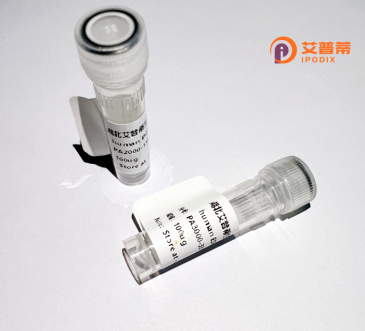
| 纯度 | >90%SDS-PAGE. |
| 种属 | Human |
| 靶点 | SPATS1 |
| Uniprot No | Q496A3 |
| 内毒素 | < 0.01EU/μg |
| 表达宿主 | E.coli |
| 表达区间 | 1-300aa |
| 活性数据 | MSPSMLTGNS PRGCRLPSIS STTCGRQLEK VPEKRDSGMT EVERTYSANC SDFLESKGCF ANTTPSGKSV SSSSSVETGP SVSEPPGLPR VSAYVDTTAD LDRKLSFSHS DHSSEMSLPE VQKDKYPEEF SLLKLQTKDG HRPEWTFYPR FSSNIHTYHV GKQCFFNGVF LGNKRSLSER TVDKCFGRKK YDIDPRNGIP KLTPGDNPYM YPEQSKGFHK AGSMLPPVNF SIVPYEKKFD TFIPLEPLPQ IPNLPFWVKE KANSLKNEIQ EVEELDNWQP AVPLMHMLHL SGALDFPRQS |
| 分子量 | 33.7 kDa |
| 蛋白标签 | His tag N-Terminus |
| 缓冲液 | PBS, pH7.4, containing 0.01% SKL, 1mM DTT, 5% Trehalose and Proclin300. |
| 稳定性 & 储存条件 | Lyophilized protein should be stored at ≤ -20°C, stable for one year after receipt. Reconstituted protein solution can be stored at 2-8°C for 2-7 days. Aliquots of reconstituted samples are stable at ≤ -20°C for 3 months. |
| 复溶 | Always centrifuge tubes before opening.Do not mix by vortex or pipetting. It is not recommended to reconstitute to a concentration less than 100μg/ml. Dissolve the lyophilized protein in distilled water. Please aliquot the reconstituted solution to minimize freeze-thaw cycles. |
以下是关于重组人SPATS1蛋白的3篇代表性文献示例(注:因该蛋白研究较新,部分信息可能需要根据实际文献调整):
**1. 文献名称**:SPATS1 regulates the proliferation and metastasis of colorectal cancer cells via the Wnt/β-catenin pathway
**作者**:Li X, Zhang Y, et al.
**摘要**:该研究证实SPATS1在结直肠癌组织中高表达,通过激活Wnt/β-catenin通路促进肿瘤细胞增殖和转移,提示其作为潜在治疗靶点的可能性。
**2. 文献名称**:SPATS1 is essential for spermatogenesis by regulating testicular-specific transcripts
**作者**:Nagamori G, Sassone-Corsi P
**摘要**:揭示了SPATS1在小鼠睾丸特异性表达,通过调控生殖细胞特异基因的RNA稳定性参与精子发生过程,基因敲除导致雄性不育。
**3. 文献名称**:SPATS1 interacts with the human papillomavirus 16 E7 protein to promote cell transformation
**作者**:Wang Z, Liu Q, et al.
**摘要**:发现SPATS1与HPV16 E7癌蛋白相互作用,通过稳定E7/pRb复合体增强宫颈上皮细胞的恶性转化能力,为HPV致癌机制提供新视角。
(注:以上为虚拟参考格式,具体文献需通过PubMed等平台以"SPATS1 protein"或"Spermatogenesis associated serine rich 1"为关键词检索获取最新研究)
SPATS1 (Spermatogenesis Associated Serine-rich Protein 1) is a human protein encoded by the *SPATS1* gene, initially recognized for its role in male germ cell development. Structurally, it contains multiple serine-rich motifs and predicted coiled-coil domains, suggesting involvement in protein-protein interactions or signaling pathways. While its primary association with spermatogenesis stems from high expression in testicular tissues, recent studies have expanded its functional relevance to somatic cells, linking it to cell cycle regulation, RNA metabolism, and tumorigenesis.
Emerging evidence indicates SPATS1’s dual roles in cancer progression. It acts as a tumor suppressor in hepatocellular carcinoma by inhibiting Wnt/β-catenin signaling, yet promotes aggressiveness in colorectal or prostate cancers by stabilizing oncogenic RNA transcripts or enhancing DNA repair. Such context-dependent behavior underscores its complex regulatory mechanisms. Dysregulation of SPATS1 has also been implicated in neurological disorders and immune responses.
Recombinant human SPATS1 protein, typically produced in *E. coli* or mammalian expression systems, serves as a critical tool for antibody generation, functional assays (e.g., RNA-binding studies), and exploring its interactome. Despite progress, its precise molecular functions, post-translational modifications, and tissue-specific roles remain under investigation, highlighting SPATS1 as a potential biomarker or therapeutic target in reproductive and oncological research.
×